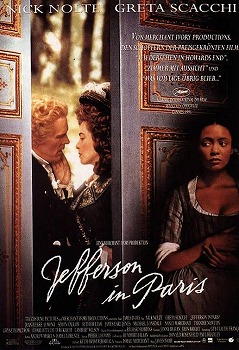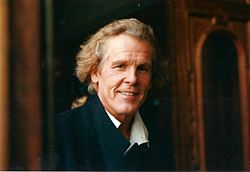Critical reception
As of February 2018, Jefferson in Paris holds a rating of 31% on Rotten Tomatoes based on 16 reviews. [6]
In her positive review in The New York Times , Janet Maslin called the film:
an extraordinary spectacle ... the rare contemporary film that's both an entertainment and an education, despite some glaring misimpressions that are sure to spark heated debate ... The biggest problem with [the film] is at the basic editing level, with such abrupt jumps between diverse scenes that the film's momentum remains choppy. Overshadowed by its own ambition and not-quite-ironic pageantry, Jefferson in Paris doesn't quite come to life ... Casting Nick Nolte as a Founding Father may sound like this film's riskiest choice, but in fact it makes solid sense. Beyond having the right physical stature for the imposing, sandy-haired Jefferson, Mr. Nolte captures the man's vigor and his stiff sense of propriety. He may not adapt effortlessly to the role of an intellectual giant, but his performance is thoroughly creditable ... The film makers fare less successfully with Maria Cosway ... Ms. Scacchi, the film's big casting problem, makes her so bloodless and prettily artificial that the romance never seems real. There's much more spice in Ms. Newton's captivating performance as Sally Hemings, even if she gives this teen-age slave girl the unexpected fiddle-dee-dee flirtatiousness of a Scarlett O'Hara. [7]
Roger Ebert of the Chicago Sun-Times observed in a less positive review of the film that:
The film is lavishly produced and visually splendid, like all the Merchant-Ivory productions. But what is it about? Revolution? History? Slavery? Romance? No doubt a lot of research and speculation went into Jhabvala's screenplay, but I wish she had finally decided to jump one way or the other. The movie tells no clear story and has no clear ideas. [8]
In a negative review appearing in Rolling Stone magazine, Peter Travers said:
After a literate and entertaining roll ( A Room With a View , Howards End , The Remains of the Day ), the team of producer Ismail Merchant, director James Ivory and writer Ruth Prawer Jhabvala drops the ball with this droopy, snail-paced prigs-in-wigs movie. It doesn't help that Nick Nolte is such a lox as Thomas Jefferson ... [He] seems to think that playing an introspective man means impersonating a wax dummy. [9]
Edward Guthmann of the San Francisco Chronicle called the film "dull, sluggish and unfocused ... [it] tries telling three or four stories at once, can't decide which is most important and winds up stubbing its well-manicured toes" and added:
Coiffed in a strawberry blond ponytail that makes him look like sitcom star Brett Butler, and surrounded by opulent sets and costumes that look like early bids for Oscar nominations, Nolte makes a noble, sympathetic effort to humanize a historical figure, but never manages to look anything other than tight, corseted and out of his element. [10]
In Variety , Todd McCarthy said the film:
touches upon much significant history, incident and emotion but, ironically, lacks the intrigue and drama of great fiction ... as the opportunity for drama increases with the onset of Jefferson's affair with Sally and the buildup toward the Revolution, the narrative becomes more dispersed and murky. Things happen ... but they don't weave and dovetail in the surprising, intricate and telling ways they can in first-class fiction, some of Merchant Ivory's recent films included ... The strong points of director James Ivory's approach here are his attentiveness to wonderful detail ... The downside is that Ivory's reticence makes it additionally tough for an emotionally remote figure like Jefferson to come alive onscreen. [11]


